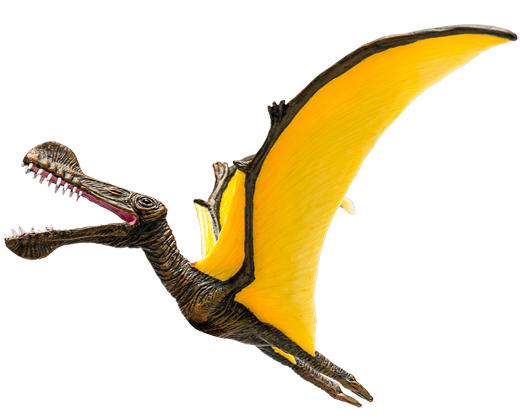New Research Explains How Large Pterosaurs Took to the Air
Newly published research suggests that large pterosaurs probably used all four limbs to propel themselves into the air, as seen in bats today. Take-off is a vital part of powered flight. The physical effort required to launch is dictated by body mass. The bigger and heavier you are, the greater the physical effort required to take to the air. This rule likely constrains the size of birds, yet extinct pterosaurs are known to have reached far larger sizes. How did pterosaurs launch?
The new study, published in the journal “PeerJ” suggest that large pterosaurs took off using a similar method as bats. In essence, the researchers conclude that big flying reptiles used all four limbs to propel themselves into the air. This is referred to as “quadrupedal launching”.

The Mojo Fun Tropeognathus pterosaur model. The researchers used a life-size computer-generated model of an ornithocheirid pterosaur such as Tropeognathus to conduct their research.
The picture above shows a typical ornithocheirid pterosaur (Tropeognathus). This is a model from the Mojo Fun prehistoric and extinct range.
To view this range of prehistoric animal figures: Mojo Fun Prehistoric Animal Models.
Quadrupedal Launching of Large Pterosaurs
This research helps scientists to understand the unique anatomy and biology of the Pterosauria. In addition, it provides a new perspective on how flying reptiles became airborne, despite some taxa having wingspans in excess of ten metres. The scientific paper sheds new light on the flight initiating jumping ability of these archosaurs.
The research was conducted by scientists at the University of Bristol, the University of Keele, Liverpool John Moores University and Universidade Federal do ABC, São Bernardo do Campo, Brazil. The team constructed a computer model of the skeleton and muscles of an ornithocheiraean pterosaur with a wingspan of five metres. Thirty-four key muscles were modelled to estimate limb movements through three alternative take-off motions.
The three alternative take-off motions:
- a vertical jump using just the hind legs, as seen in many ground-dwelling birds.
- a less vertical jump using just the legs, more similar to the jump used by birds that fly frequently.
- a four-limbed jump using the wings as well in a motion more akin to the take-off jump of a bat.
By reproducing these take-off motions using the large pterosaur model, the team were able to understand the forces generated to push the reptile into the air.

A replica of an ornithocheirid pterosaur based on Cambridge Greensand fossil remains. Picture credit: Everything Dinosaur.
Picture credit: Everything Dinosaur
The Bigger the Animal the Greater the Challenge of Becoming Airborne
Lead author of the study, Dr Ben Griffin (University of Bristol), explained:
“Larger animals have greater challenges to overcome in order to fly making the ability of animals as large as pterosaurs to do so especially fascinating. Unlike birds which mainly rely on their hindlimbs, our models indicate that pterosaurs were more likely to rely on all four of their limbs to propel themselves into the air.”
The researchers examined one of the long-standing questions about the underlying biomechanics of the Pterosauria. This study not only enhances the understanding of pterosaur biology but also provides broader insights into the limits and dynamics of flight in large vertebrates. By comparing pterosaurs with modern birds and bats, this research highlights the remarkable evolutionary solutions to the challenge of powered flight.
There are no living analogues for large pterosaurs. Hence, scientists rely on computer modelling to provide data on these remarkable creatures. After all, pterosaurs were the first vertebrates to evolve powered flight.
Everything Dinosaur acknowledges the assistance of a media release from the University of Bristol in the compilation of this article.
The scientific paper: “Modelling take-off moment arms in an ornithocheiraean pterosaur” by Benjamin W. Griffin, Elizabeth Martin-Silverstone, Rodrigo V. Pêgas, Erik Anthony Meilak, Fabiana R. Costa, Colin Palmer and Emily J. Rayfield published in PeerJ.
The award-winning Everything Dinosaur website: Pterosaur Models and Toys.

